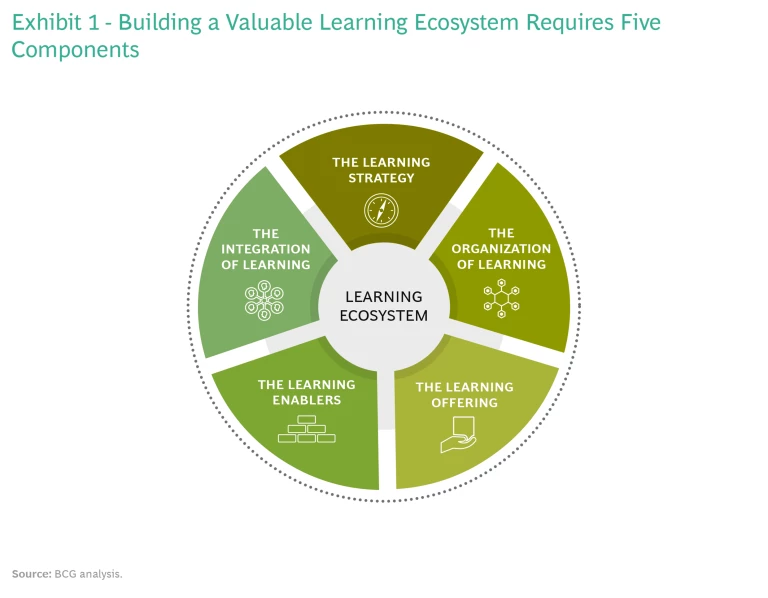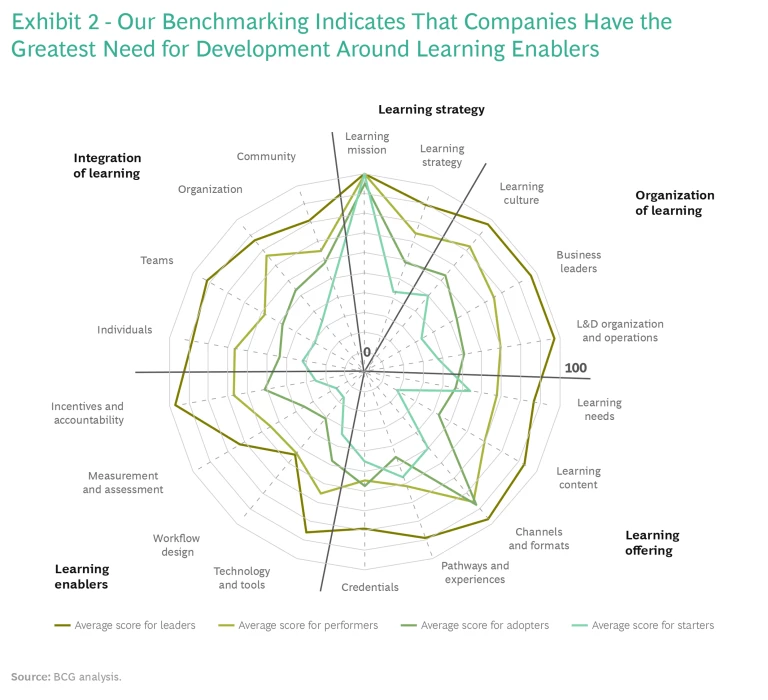It’s harder than ever to stay in business—let alone run at the front of the pack. Leaders have to navigate what has become the new status quo: an uncertain, fast-changing business environment created by disruptive technologies, economic volatility, geopolitical instability, and unpredictable events brought on by systemic climate change and shocks, such as the current pandemic.
What is the best strategy for not just beating back the threat of failure but creating lasting competitive advantage? Learning how to learn. By building advanced continuous-learning organizations—and doing so as quickly as possible—leaders can attract and retain the best talent and boost performance in the short term, sustaining the growth of skills and development well into the future.
A System for Learning
Learning is the foundational capability that organizations need to address the range of obstacles threatening their sustainability and success. It should be a unique, customized system like any other critical building block within an organization—as elemental as strategy, planning, innovation, and people management. Developing that learning system is a two-step process.
A system of learning should be unique and customized, like any other critical building block within an organization—as elemental as strategy, planning, innovation, and people management.
First, leaders need to be ready to continuously anticipate the skills that their organizations will need—many of them associated with fast-changing digital technologies—and then build and assess those skills quickly, at scale, and across the organization.
Second, leaders need to establish a foundation for learning that allows the organization to maintain a habit of ongoing digital reskilling and upskilling in order to stay ahead of the next wave of change. Today, the half-life of skills is not even five years—fewer than three for digital skills.
Now is the time to take this challenge on. A new generation of technology—including AI-powered e-learning and coaching, as well as extended reality training—makes learning more streamlined, user-friendly, customizable, and effective.
And the appetite to learn is voracious. UNESCO, the UN agency that promotes international cooperation in education, the sciences, and culture, has calculated that some 470 million people will demand higher education over the next 15 years—the equivalent of building eight new universities for 40,000 students every week. The public sector may be able to address some portion of this problem, but companies will have to find their own ways to bridge the global skills mismatch.
Stepping Up the Advanced Learning Game
Through our reskilling and upskilling work with companies in the private and public sectors—along with our efforts to help organizations become long-term learners on their own—we’ve found that the ideal learning ecosystem has five core components (see Exhibit 1):
- A business-driven learning strategy
- A learning culture supported by a well-resourced and agile learning and development function
- A personalized library of content for individuals and teams
- Enabling technology, which can continuously analyze and assess the programs and their impact
- A clear way to integrate organizational learning and potentially foster external collaboration.
To understand how far along companies are in the pursuit of building these five components and becoming advanced learners, BCG conducted a learning ecosystem maturity assessment with more than 60 of the world’s leading companies. The results show that less than 20% are world-class learning enterprises, a group we call leaders; about one-third, called performers, have the potential to reach that level if they fix some of the cracks in their learning ecosystems. (See Exhibit 2.)
When we investigated the results further, we found that that there was a striking gap between what companies say they want to do, as expressed by their learning strategy, and what they actually accomplish. Companies overall achieved an impressive score of 83 points out of 100 for the way they developed their learning strategy. In other words, most—even so-called starters, where activating a learning ecosystem is very much an afterthought—put it at the heart of their mission.
But even learning leaders struggle to put the words of their well-crafted mission statements into action, because they lack the necessary enabling infrastructure that forms the foundation of any successful learning ecosystem. On average, companies earned a score of 48 points for what we call the learning enablers domain, the weakest result across all five domains of a learning ecosystem. If they had earned such a low score in the other four domains, all the companies would have ended up in the two lowest maturity categories: starters and adopters.
Learning from Learning Enablement Leaders
To create an environment that allows for the learning strategy to be put into action, organizations should focus on four primary angles: workflow design, technology and tools, measurement and assessment, and incentives. Although most companies are struggling to build the learning structure they need, some are doing an excellent job of supporting a successful ecosystem and demonstrating valuable best practices for each of these four learning enablers.
Workflow Design. In 1885, Hermann Ebbinghaus, a German psychologist, devised the so-called forgetting curve: a steeply declining line that reflects the sudden fall in what we remember after first learning a piece of information. He concluded that, in order to slow the rate of decline, it was necessary to put learning into practice on a frequent basis.
To fight the forgetting curve, employees need relevant, personalized, easily digestible lessons ingrained into the everyday rhythm of their daily work.
Today, it is a widely accepted theoretical concept that people more successfully retain information through experiential learning that is integrated into their regular workflow (70%), rather than through social learning (20%) or formal training (10%). But organizations often struggle to find ways to embed learning into daily routines and habits, such as implementing microlearning units throughout the workweek and turning managers into learning coaches who support their employees and help them thrive.
To fight the forgetting curve, employees need relevant, personalized, easily digestible lessons ingrained into the everyday rhythm of their daily work and reinforced by virtual coaching; nudges, such as quick email reminders or push notifications; and games. Learning should become business as usual. (See “Daily Learning at Visa.”)
Daily Learning at Visa
As Visa’s global head of learning enablement puts it, this is the front door through which employees can pass to “socialize, collaborate, and get personalized recommendations.” It serves as the central hub for all of Visa’s 80,000 pieces of instantly available curated content, which it has either created or sourced from external providers.
Launched in March 2020, when many companies enforced work-from-home regulations, the platform was used by 65% of Visa’s employees within the first four months—an extraordinary level of engagement. It proved attractive because employees were given content that was presented in a way that aligned with their interests and could be consumed during their working day. Also, by offering a more unified user experience, the platform helped keep people together during pandemic lockdowns.
Technology and Tools. Throughout the past five years, learning technology has evolved at an incredible pace. Today, the success of a company’s learning endeavor relies heavily on adopting the right digital technology across the whole learning journey, including tools that can assess skills, provide live or online content, and offer self-paced discovery and social learning. Also effective is on-the-job integration of learning through games, projects, and challenges.
A well-rounded learning offering requires a lot of different tools, such as a learning management system, content libraries, coaching and nudging tools, and microlearning and credentialing platforms. One challenge for learning and development teams is to make the right make-or-buy decisions and ensure not only a personalized experience but seamless integration into all other HR processes. (See “ChargePoint’s Powerful Training.”)
ChargePoint’s Powerful Training
A key to ChargePoint’s success is the huge network of external contractors who install its charging stations. But the company was spending excessive time, and a small fortune, on training and supporting these installers, often fielding “how to” questions and other basic queries. To address this, the company partnered with the Dublin-based company LearnUpon, which has developed a popular cloud-based learning management system. This system allows installers to access learning modules on their phones and receive automated certifications as well as reminders and other alerts when new learning updates become available.
The benefits for ChargePoint were immediate: the training completion rate increased by 28%, and the number of support calls from installers dropped by 89% in the first year. The system has been so successful that the company has begun rolling it out to other groups of employees, starting with the sales team.
Measurement and Assessment. Organizational learning is only as good as the ability to prove its impact. Organizations need to determine whether they are moving in the right direction in their pursuit to become advanced learners—and if they are moving fast enough on both individual and organizational levels to fill skills gaps and live up to employees’ learning expectations. This requires a robust set of analytics that effectively, reliably, and consistently gauge employee performance and development across all dimensions—including skills anticipation and AI-based capability assessments to determine learning needs as well as the identification of a clear business case and return on learning investment. To create impact, it’s just as important to learn as it is to assess what is needed to learn, analyze the best way to learn, and measure what has been learned along the way.
Companies have to look at measurement from at least two perspectives (see “Effective Evaluations at BIC”):
- A holistic view on efficiency and the outcomes of learning experiences, with a focus on programs and initiatives
- An approach that measures competencies, with a focus on individuals and their skills
Effective Evaluations at BIC
Working with learners and their managers, the company created a systematic evaluation approach designed to identify the strengths and weaknesses of each training program. This approach provided a meaningful way to measure performance improvement and could be used globally.
After launching the approach, the company saw high participation rates—80% to 90%—in the evaluations. Using the results over the course of three years, the company worked on continuous improvements of its 15 main learning programs. This effort has boosted the performance of its programs from four that were above industry average to twelve and cut underperforming programs from five to zero.
Incentives. Motivation is key to establish a culture that celebrates the critical role of learning in personal development. Incentives, therefore, are critical for learners and business leaders who can themselves grow by helping others to do the same. These can include the kind of nonfinancial stimulus that keeps people motivated and encourages others, such as recognizing leading learners and learning coaches through companywide communications. But they can also be financial, such as by offering learning subsidies and by making learning a part of formal evaluation and a clear influence on bonus and promotion decisions. Incentives can convert extrinsic motivation into intrinsic motivation, which is arguably more powerful and longer lasting. (See “Education Incentives at Walmart.”)
Education Incentives at Walmart
The education-focused Lumina Foundation conducted a study of LBU three years after its launch in 2018 to find out if the program had led to any tangible outcomes. Results showed growth in attendance—from 4,000 active students in 2018 to 30,000 in 2021—as well as an increase in the number of programs offered (from 50 to 100 over the same time frame).
LBU has also led to a significant decrease in employee attrition (participants were four times less likely to leave the company than nonparticipants) and higher rates of promotion (participants were almost twice as likely to receive a promotion). In addition, LBU has generated greater productivity, with students demonstrating about a 10% improvement in performance ratings within six months of enrolling.
Learning enablers are, on average, the least developed of the five core components required to build an advanced learning ecosystem—often relegated to HR or technology departments instead of getting attention within learning and development teams. At some companies, they’re not on the radar at all.
But making an effort to improve this part of the overall learning journey can be one of the most efficient ways for organizations to learn and grow fast, especially if they already have well-developed content, an agile and robust learning and development function with strong digital talent, and a leadership team that promotes and fosters learning. The four enablers listed above can be the best means of unlocking learning ROI and overall business impact.
The goal is no longer to accumulate knowledge. That approach, which served companies well for many decades, isn’t sufficient because learned information becomes outdated so quickly. Organizations need a learning ecosystem that facilitates continuous capability building and upskilling in the workplace—equipping people at all levels with future-critical knowledge, skills, and behaviors. The best talent out there wants to grow and is hungry to learn. The organizations that can learn the fastest, harnessing the power of people and technology to adapt in changing environments, will win.








